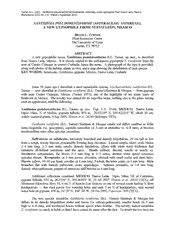
Xanthisma pseudorestiforme (Asteraceae: Astereae), a new gypsophile from Nuevo Leon, Mexico PDF
Preview Xanthisma pseudorestiforme (Asteraceae: Astereae), a new gypsophile from Nuevo Leon, Mexico
XANTHISMA PSEUDORESTIFORME (ASTERACEAE: ASTEREAE), A NEW GYPSOPHILE FROM NUEVO LEON, MEXICO Turner Billie L. Plant Resources Center The University of Texas TX 78712 Austin, ABSTRACT A \ new g\psophilK ti oil nifhisii.a pseudorestiforme B.L. Turner, sp. nov., is described from Nuevo Leon, Mexico. closely related to the well-known gypsophile X. restiforme from the It is A area of Cuatro Cienegas in central Coahuila, hence the name. photograph of the type provided, is map along with photos of the habitat, plants in vivo, and a showing the distribution of each species. KEY WORDS: Asteraceae, Xanthisma, gypsum, Mexico, Nuevo Leon, Coahuila Some 30 years ago described a most remarkable species, Machaeranthera restiformis B.L. — 1 — & Turner now identified as Xanthisma restiforme (B.L. Turner) Hartman Morgan from gypsum soils near Cuatro Cienegas, Mexico (Turner 1973), one of the highlights of my many years of fieldwork in Mexico. The novelty was named for rope-like stems, nothing else in the genus having its such an appearance, until the following: MEXICO. Xanthisma pseudorestiforme B.L. Turner, sp. nov. Figs. 1-5. TYPE: Nuevo Leon. N Mpio. Mina, of Molina, gypsum 854 m, 26.02219° N, 100.422211° W, shrub 20 cm, hillside, widely scattered plants, 4 Sep 2005, Hinton et al. 28398 (holotype: TEX). & Xanthismi restiformi (B.L. Turner) Hartman Morgan similis sed differ! caulibus ac foliis mm dense hispidulis (vs. gossypinis), capitulis minoribus (4-5 in altitudine vs. 6-8 mm), et bracteis involucralibus setas albas apicales carentibus. cm Suffruticose or subshrubs, intricately branched and densely hispidulous, 30 tall or less from a tough, woody taproot, presumably forming deep rhizomes. Leaves simple, short, ovate blades mm 2-4 long, 2-3 nun wide, sessile, densely hipidulous, ciliate with white waxy trichomes that terminate ill-defined serrations and the apex. Heads solitary, discoid, sessile or nearly so. mm 2-5 3-5 Involucres campanulate, the bracts long in series, distinct white apical setaceous mm apiculae absent. Receptacles ca 5 across, alveolate, adorned with small scales and short hairs. mm mm 30-60 Florets yellow, pel' head; corollas ca 4 Song, 5~iobed, the lobes acute, ca 1 long. Style mm branches flat with densely pubescent, acute appendages. Aehenes prismatic, ca 1.8 long, mm densely white-pubescent; pappus of numerous stiff bristles ca 4 long. MEXICO. NE Additional collection-, examined Nuevo Leon. Mpio. Mina: of Carricitos, gypsum hillside, 935 m, 26.0136° N, 100.46592° W, 23 Jul 2007, Hmton et al. 28633 (TEX); off N N Hwy Monterrey-Monclova 53, 6 mi of Rancho Las Estacas on one of several roads leading from — N headquarters this road passes two watering holes and ends 7 mi of headquarters, near second water hole on gypsum, 650 m, 26° 25' N, 100° 50' W, 18 Oct 1993, Patterson 7436 (TEX). & The new species resembles Xanthisma restiforme (B.L. Turner) Hartman Morgan but mm differs in its densely hispidulous steins and leaves (\^ cotton^ -pubeseeuf snniLi heads (4-5 ). high vs 6-8 mm), and involucral bracts without apical white bristles. The novelty indeed resembles X. restiforme so much in habit so that I have coined its name after the fact. No doubt the two taxa are Turner: Xanthisma pseudorestiforme, new gypsophile f derived from some ancient gypseous rhizomatous population, this giving rise to the two remarkable — populations known today one in Coahuila, the other in Nuevo Leon (Fig. The locality for X. 1). pseudorestiforme also the home of two other recently described gypsophilous endemics, Erigeron is heleniae Nesom (Nesom 2007) and Cryptantha geohintonii B.L. Turner (Turner 2008). my Xanthisma pseudorestiforme first came to attention in 1993 by a collection of Thomas F. new Patterson (cited above). I annotated it as a possible species at the time, hoping that additional my specimens might be obtained by others, and such has been provided by good friend George Hinton, who obtained two more collections, including the type and a color photograph of the same. In his covering letter (email), George commented: On Sunday went to a gypsum outcrop near Monterrey; and as got out of the truck saw a real I I nice Asteraceae, a dominant species. I thought that if no one had been collecting on that gypsum (most likely) it would surely be undescribed. Then yesterday night I went to the PR.C website [Plant Resources Center, TEX] and found that you had collected on gypsum near — it NW Cuatro Cienegas over 100 miles to the of the Nuevo Leon site and 30 years earlier! George's intuition was correct, of course, but his web site examination could not have picked up the differences that distinguish between the species concerned, nor did he know that had I my away squirreled the single sheet of the potential novelty at disposal, as noted above. ACKNOWLEDGEMENTS I am grateful to Guy Nesom for the Latin diagnosis and comments on the paper and to Tom Wendt for the photograph of the holotype. Many thanks to George Hinton for his interesting letter, some of this quoted above, and the excellent collections and photos. LITERATURE CITED A Nesom, G.L. 2007. new gypsophilous species of Erigeron (Asteraceae: Astereae) from northeastern Mexico. Bot. Res. Texas 891-894. J. Inst. 1: Turner, B.L. 1973. Machaeranthera restiformis (Asteraceae), a bizarre new gypsophile from northcentral Mexico. Amer. Bot. 60: 836-838. J. Turner, B.L. 2008. Cryptantha geohintonii (Boraginaceae), a newly described gypsophile from Nuevo Leon, Mexico. Phytologia 90: 406^09. x Turner; Xanthisma pseucbrestiforrne, new gypsophile from Mexico 3 *-f vr^./"i /"''*'% Coahuila 1 ' A \ •4 \ \fV W ^ '" yo «. .. .; — '**' 1 vW •V, 1 Nuevo Leon /,7 , --V, ;\ 1 \ XANTHISMA O pseudorestiforme 9 restiforme Figure Distribution ofXanthisma restiforme olldX pseudorestifor 1 . 4 Turner: Xanthisma pseudorestiforme, new gypsophile from Mexico ^ *#>• 1,1 ill, 1 1, Figure Xanthisma pseudorestiforme (holotype, TEX). 2.
